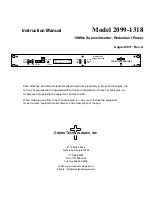
Serial Communication Interface (SCI)
Operating Modes
MOTOROLA
DSP56309UM/D 8-21
In synchronous mode, data is synchronized with the transmit clock, which can have
either an internal or external source, as defined by the TCM bit in the SCCR. The length
and format of the serial word is defined by the WDS0, WDS1, and WDS2 control bits in
the SCR. In asynchronous modes, the start bit, the eight data bits (with the LSB first if
SSFTD = 0 and the MSB first if SSFTD = 1), the address/data indicator bit or parity bit,
and the stop bit are transmitted in that order.
The data to be transmitted can be written to any one of the three STX addresses. If SCKP
is set and SSHTD is set, the SCI synchronous mode is equivalent to the SSI operation in
the 8-bit data on-demand mode.
Note:
When writing data to a peripheral device, there is a two cycle pipeline delay
until any status bits affected by this operation are updated. If you read any of
those status bits within the next two cycles, the bit does not reflect its current
status. See the
DSP56300 Family Manual, Appendix B, Polling a Peripheral
Device for Write
for further details.
8.4
OPERATING MODES
The operating modes for the DSP56309 SCI are these:
¥ 8-bit synchronous (shift register mode)
¥ 10-bit asynchronous (1 start, 8 data, 1 stop)
¥ 11-bit asynchronous (1 start, 8 data, 1 even parity, 1 stop)
¥ 11-bit asynchronous (1 start, 8 data, 1 odd parity, 1 stop)
¥ 11-bit multidrop asynchronous (1 start, 8 data, 1 data type, 1 stop)
This mode is used for master/slave operation with wakeup on idle line and
wakeup on address bit capability. It allows the DSP56309 to share a single serial
line efficiently with other peripherals.
These modes are selected using the WD[0:2] bits in the SCR.
The synchronous data mode is essentially a high-speed shift register used for I/O
expansion and stream-mode channel interfaces. Data synchronization is accomplished
by the use of a gated transmit and receive clock that is compatible with the Intel
Ò
8051
serial interface mode 0.
Asynchronous modes are compatible with most UART-type serial devices. Standard
RS232C communication links are supported by these modes.
Содержание DSP56309
Страница 25: ...xxii DSP56309UM D MOTOROLA Figure D 25 Port E Registers PCRE PRRE PDRE D 39 ...
Страница 30: ...MOTOROLA DSP56309UM D 1 1 SECTION 1 DSP56309 OVERVIEW ...
Страница 47: ...1 18 DSP56309UM D MOTOROLA DSP56309 Overview DSP56309 Architecture Overview ...
Страница 48: ...MOTOROLA DSP56309UM D 2 1 SECTION 2 SIGNAL CONNECTION DESCRIPTIONS ...
Страница 85: ...2 38 DSP56309UM D MOTOROLA Signal Connection Descriptions OnCE JTAG Interface ...
Страница 86: ...MOTOROLA DSP56309UM D 3 1 SECTION 3 MEMORY CONFIGURATION ...
Страница 104: ...MOTOROLA DSP56309UM D 4 1 SECTION 4 CORE CONFIGURATION ...
Страница 124: ...MOTOROLA DSP56309UM D 5 1 SECTION 5 GENERAL PURPOSE I O ...
Страница 125: ...5 2 DSP56309UM D MOTOROLA General Purpose I O 5 1 INTRODUCTION 5 3 5 2 PROGRAMMING MODEL 5 3 ...
Страница 128: ...MOTOROLA DSP56309UM D 6 1 SECTION 6 HOST INTERFACE HI08 ...
Страница 166: ...MOTOROLA DSP56309UM D 7 1 SECTION 7 ENHANCED SYNCHRONOUS SERIAL INTERFACE ESSI ...
Страница 212: ...MOTOROLA DSP56309UM D 8 1 SECTION 8 SERIAL COMMUNICATION INTERFACE SCI ...
Страница 241: ...8 30 DSP56309UM D MOTOROLA Serial Communication Interface SCI GPIO Signals and Registers ...
Страница 242: ...MOTOROLA DSP56309UM D 9 1 SECTION 9 TRIPLE TIMER MODULE ...
Страница 269: ...9 28 DSP56309UM D MOTOROLA Triple Timer Module Timer Operational Modes ...
Страница 270: ...MOTOROLA DSP56309UM D 10 1 SECTION 10 ON CHIP EMULATION MODULE ...
Страница 302: ...MOTOROLA DSP56309UM D 11 1 SECTION 11 JTAG PORT ...
Страница 369: ...C 22 DSP56309UM D MOTOROLA DSP56309 BSDL Listing ...
Страница 370: ...MOTOROLA DSP56309UM D D 1 APPENDIX D PROGRAMMING REFERENCE ...
Страница 405: ......
Страница 409: ......
















































